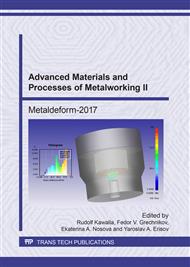[1]
C. Kawalla et al., An empirical examination of the formation of the thickness profile of Twin-Roll-Cast strip, forthcoming (2017).
Google Scholar
[2]
B. Frischknecht, Aluminium 77 (2001) 746-751.
Google Scholar
[3]
J. Strid, Twin roll casting, a technological overview, Proceedings 3rd International Conference on Aluminium Alloys, Vol. III, Trondheim, 1992, 321-356.
Google Scholar
[4]
H. Hoffmann, R. Neugebauer, G. Spur, Handbuch Umformen, Carl Hanser Verlag, München, (2012).
Google Scholar
[5]
U. Albrecht-Früh, Prozeßdatengestützte Modellbildung des Banddickenprofils beim Dünnbandgießen nach dem Zweirollenverfahren, Shaker Verlag, Aachen, (1997).
Google Scholar
[6]
S. Bernhard, Zur Regelung und Steuerung von Bandgießanlagen nach dem Zwei-Rollen-Verfahren, VDI-Verlag, (1993).
Google Scholar
[7]
M. Enning, Beitrag zur Dickenregelung beim Gießwalzen von Bändern, VDI-Verlag, (1993).
Google Scholar
[8]
M. Sarstedt et al., Partial least squares structural equation modeling (PLS-SEM): A useful tool for family business researchers, Journal of Family Business Strategy 5 (2) (2014) 105-115.
DOI: 10.1016/j.jfbs.2014.01.002
Google Scholar
[9]
J. F. Hair, C. M. Ringle and M. Sarstedt, PLS-SEM: Indeed a silver bullet, Journal of Marketing theory and Practice 19 (2) (2011) 139-151.
DOI: 10.2753/mtp1069-6679190202
Google Scholar
[10]
J. F., Hair Jr et al., A primer on partial least squares structural equation modeling (PLS-SEM), SAGE Publications, Thousand Oaks, (2017).
Google Scholar
[11]
C. Kawalla, M. Hoeck, Quality assurance system for hot rolled TRC magnesium strips, Scientific Papers of Silesian University of Technology. Organization and Management Series. forthcoming (2017).
DOI: 10.29119/1641-3466.2017.100.13
Google Scholar
[12]
C.M. Ringle, S. Wende and J.M. Becker. 2015. SmartPLS 3., Boenningstedt: SmartPLS GmbH, http: /www. smartpls. com.
Google Scholar
[13]
J. Henseler, C.M. Ringle and M. Sarsted, Using partial least squares path modeling in advertising research: basic concepts and recent issues, in: S. Okazaki (Eds. ), Handbook of research on international advertising, Edward Elgar Publishing, Inc., 2012, pp.252-276.
DOI: 10.4337/9781781001042.00023
Google Scholar
[14]
R. Weiber, D. Mühlhaus, Strukturgleichungsmodellierung: Eine anwendungsorientierte Ein-führung in die Kausalanalyse mit Hilfe von AMOS, SmartPLS und SPSS, Springer-Verlag, Berlin Heidelberg, (2014).
DOI: 10.1007/978-3-642-35012-2
Google Scholar
[15]
J. Henseler, C. M. Ringle and R. R. Sinkovics, The use of partial least squares path modeling in international marketing, Advances in international marketing 20 (2009) 277-319.
DOI: 10.1108/s1474-7979(2009)0000020014
Google Scholar
[16]
M. Tenenhaus et al., PLS path modelling, Computational statistics & data analysis 48 (1) (2005) 159-205.
Google Scholar
[17]
J. Betzin, J. Henseler, Einführung in die Funktionsweise des PLS-Algorithmus, in: F. Bliemel (Eds. ), Handbuch PLS-Pfadmodellierung. Methode, Anwendung, Praxisbeispiele. Schäffer-Poeschel, Stuttgart, 2005, pp.49-70.
DOI: 10.15358/0340-1650-2005-2-70
Google Scholar
[18]
T. Waurick. Prozessorganisation mit Lean Six Sigma: eine empirische Analyse. Springer-Verlag, Wiesbaden, (2014).
DOI: 10.1007/978-3-658-07754-9_2
Google Scholar
[19]
A. Diamantopoulos, P. Riefler. Formative Indikatoren: Einige Anmerkungen zu ihrer Art, Validität und Multikollinearität. Zeitschrift für Betriebswirtschaft, 78 (2008), 1184-1196.
DOI: 10.1007/s11573-008-0099-7
Google Scholar
[20]
J.F. Hair, M. Sarstedt, C.M. Ringle, J.A. Mena, 2012. An assessment of the use of partial least squares structural equation modelling in marketing research. Journal of the Academy of Marketing Science 40 (3), 414-433.
DOI: 10.1007/s11747-011-0261-6
Google Scholar
[21]
S. Geisser, A predictive approach to the random effects model, Biometrika, 61 (1994) 101-107.
Google Scholar
[22]
M. Stone, Cross-validatory choice and assessment of statistical predictions, Journal of the Royal Statistical Society, 36 (1974) 111-147.
DOI: 10.1111/j.2517-6161.1974.tb00994.x
Google Scholar


